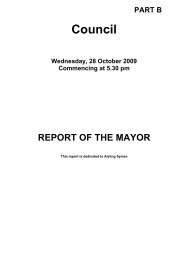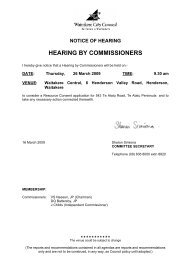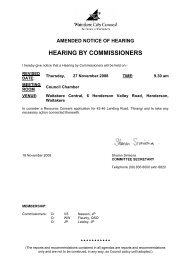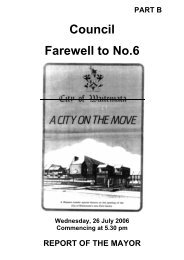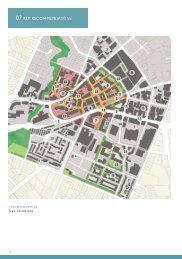'Street Lighting Update' produced by Local ... - Auckland Council
'Street Lighting Update' produced by Local ... - Auckland Council
'Street Lighting Update' produced by Local ... - Auckland Council
You also want an ePaper? Increase the reach of your titles
YUMPU automatically turns print PDFs into web optimized ePapers that Google loves.
StreetlightingLED future bright – present less clearAtrial carried out <strong>by</strong> North ShoreCity <strong>Council</strong> found that whileLEDs have a bright future asstreetlights, they are not quite there yet.Mike Russell, senior asset engineer inthe council’s transport department, saidthe trial in underlit streets in Brown’s Bayand Sunnynook <strong>produced</strong> variableresults.“The council was keen on the greenside of things and were getting a bitalarmed <strong>by</strong> the power bills, so weinvestigated some energy saving optionsin lighting,” he said.The existing lights had been upgradedover the years to high-pressure sodiumand the council wanted to see how theLEDs would compare.The test area had a mix of 50-,100- and 150-watt HPS luminaries andthese were replaced with 60-watt MaserLEDs, fitted to the existing lampposts.“The LEDs we fitted were rated60-watt, but we found they consumedmore than that when we measured them.We made savings on the 100- and150-watt HPS, but the power costs werehigher than the 50-watt lights.”The quality of the light was the otherissue, with mixed results again.“In terms of lux, the LEDs gave morelight than the 50-watt lights, but lessthan the others. Also, the luminaries weused had an almost stage-light effect;they gave pools of light, which isn’t greatfor street-lighting.”The council surveyed the residents andthose living in the streets that had beenserviced <strong>by</strong> 50-watt HPS lights were mosthappy with the improvements.“We found people generally liked thewarmer white light and liked being moreenergy efficient. In the 50-watt areapeople were happiest, but in the150-watt areas they were more polarised.We got comments about the spotlighteffect and that people didn’t feel theywere as safe as they felt under the oldlights.”Residents found that the reduction inlight under the LEDs offset the betterlight perception.There were also issues around cost.“We found that LEDs weren’t going tobe better value than the 50-watt HPSlights and while we would save money on100-watt lights, we wouldn’t recover theinitial cost over the lifetime of the light.In the 150-watt areas we would recoverthe initial costs in about six years.”The problem was that the only realsavings to be made were <strong>by</strong> reducing thelevel of light.“The lighting was substandard in thoseareas before the trial and it was stillsubstandard afterwards. But we thinkthe result can be improved usingdifferent luminaries to spread the lightmore.“We recommended that the councilwatch this space, really, and when thereare new developments in LED technologythen we could do a desktop comparisonof life-cycle costs. There are betterluminaries already out there and thecosts are coming down. I think we’re notthere yet, but things are developing andwe see a place for LEDs in the future.”Page 11 of IP66 in comparison tostandard lights (IP54).This higher rating has the benefit ofallowing maintenance periods to beincreased from three to four years, withan associated decrease in maintenancevisits over the 25-year operational life ofthe luminaire.Manukau City <strong>Council</strong> conducted aninformal desk-top study of various typesof lamps and ballasts to gain anindication of ballast losses versusnominal lamp wattage as the ElectricityCommission begins looking at ballastlosses in street lighting electricity usagebased on an assumption of 13 per centballast loss.Lamps compared <strong>by</strong> Manukau wereCosmopolis, HPS, HPS twin arc andmetal halide using a range of wattages35, 60, 70, 100, 140,150 and 250. Fortheir purposes they assumed thenominal wattage shown on the lampwas the actual lamp wattage. Theballasts used were magnetic choke andelectronic.As a simple best-case indicator thelowest ballast loss of 7.2 per cent was fora 100-watt HPS Lucalox. That is, only 7.2watts was attributed to the ballast lossfor this set-up. The next bestperformance was 70-watt SONI HPS withmagnetic ballast giving nominal lampwattage versus ballast loss wattage of8.9 per cent.It was thought that both cases mighthave suffered from the actual lampwattage being lower that the nominallamp wattage. The question thatremains after the desk-top study iswhether the Electricity Commissionsassumption of a 13 per cent ballast lossis correct? More formal research isrequired to confirm this.Waitakere has begun investigatingenergy efficient lighting opportunitiesin the outdoor area too – in its parksand walkways around transport nodes.It has installed seven 30-watt solarlights for a walkway from a train station,six 30-watt solar lights with timers atClemway Park and LED lights are beinginstalled on 7km of Project Twin StreamsCycleways using Beta-Rudd LEDway.This will be the biggest LED project inNew Zealand.Waitakere’s recommendations fortrialling new technologies include using aminimum of two luminaires next to eachother on a street.If possible include new poles to enablethe correct spacing for the light fittingbeing trialled and examine the wattageof the light and control gear, and ask forinformation about ballast losses.In New Zealand we must often installand trial the technology to be able toassess it, particularly if we are not familiarwith it.We must consider the long-term costimplications and not just the capitalpurchase costs.We must review foreign examples ofenergy efficient street lightingprogrammes, especially those coming outof Europe, as they are well advanced inusing more efficient street lightingtechnologies.And we should always challenge the‘business as usual’ model and make sureour business cases are well informed.14New ZEALAND LOCAL GOVERNMENT - SEPTEMBER 2009



